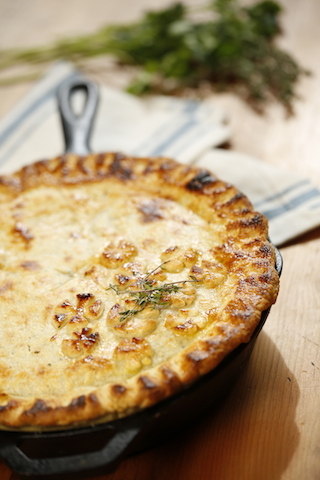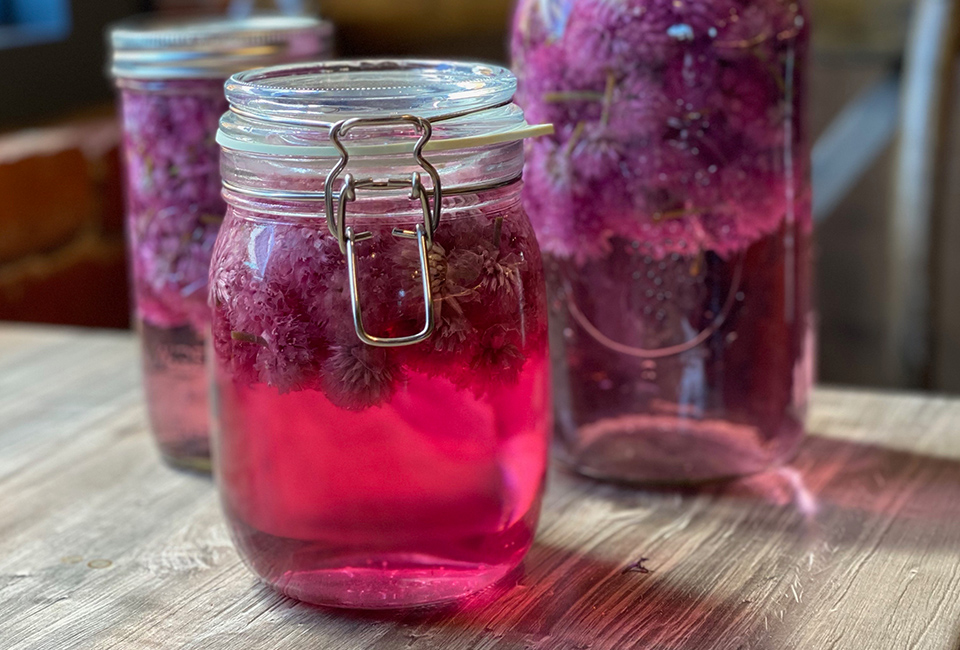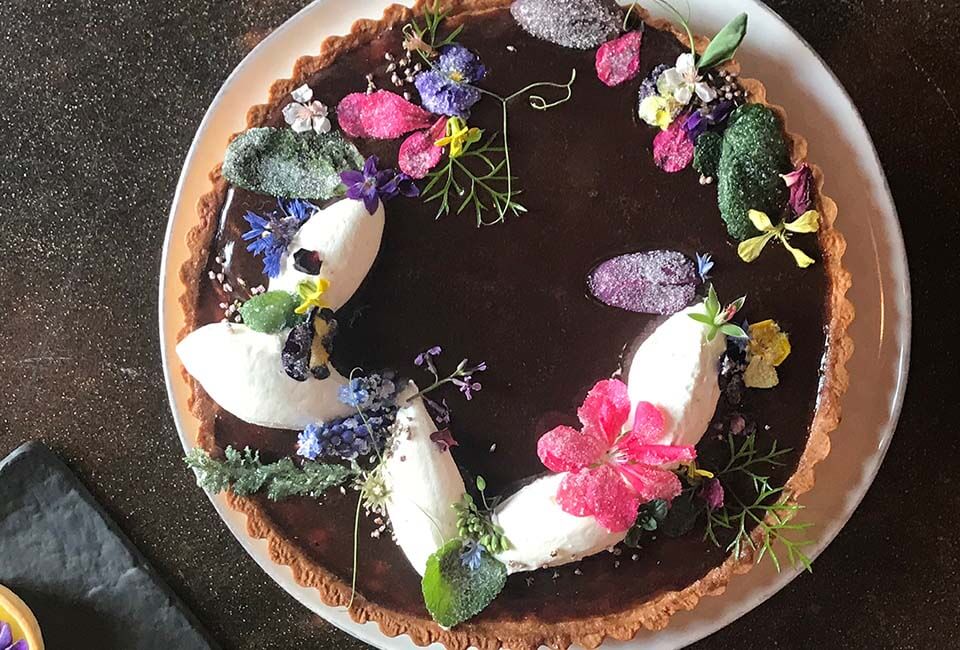Celebrating Spring in the Rockies… and a French term or two
Chef Deb Traylor
For those of us lucky enough to call Colorado home, we know spring can mean sunny warm days on Wednesday and 6-9 inches of snow by Friday. Like everyone else, I perk up when the trees begin to bud and tentative blossoms peek out after a mild winter.
But as we celebrate spring in the Rockies, we also know we’re not finished with late snowstorms, and many of us worry a bit about how it will affect our fruiting trees. While I count the days until I can safely put away my winter clothes, I silently pray that the weather won’t get too warm too soon. It’s a fine little spring dance we do with Mother Nature. If you’re a farmer, gardener, local-food-focused chef or farmers’ market regular, you understand. Late spring freezes means we won’t have our cherished harvest of apricots, cherries, plums and peaches.
So, while we teeter between the edge of winter and spring waiting for our fruit trees to produce, we thought we’d offer this recipe for Spring Chicken Pot Pie with Herbed Crust. To make it easy, you can use rotisserie chicken, store-bought stock and frozen peas. You can even cull leftovers from your fridge, too. This recipe is merely a suggestion, so feel free to add the herbs you prefer, or leave out the peas, or add more potatoes if that’s what you have on hand. In my own little world, I’d just have a pie full of potatoes and chicken and no one around to help me eat it!
A French Term or Two
When you read our recipes you’ll notice a few French cooking terms. Many of you may already know them, but I always describe the term, how it’s used and how it applies to the recipe. To be honest, I’m a food nerd; I always use the proper term for a cooking technique. I honestly feel that people who love to cook, and people learning to cook, can benefit from knowing the proper cooking terms for techniques.
Let me give you an example: When searing food, and a crust develops on the bottom of the pan, it is called the “fond,” but the TV shows call it “browned food bits”… I laugh every time I hear this. It’s like calling a “light switch” the “little flippy thingy.” Both are correct, but one of them offers a simple, true definition.
I believe we’re a community of cooks, we all have something to offer each other, and together we become better cooks. So, when you’re watching a food show and some lovely cooking person says they are going to add wine to the pan (it’s deglazing, BTW) to get “those little yummy bits “ off the bottom of the pan, I say raise your glass of wine/tea/coffee and reply, “Hey, it’s called fond!!”
On that note, today’s cooking term is: Beurre Manié [bur man-yay], noun: A kneaded paste of butter and flour added to a soup or sauce toward the end of cooking in order to thicken. It’s usually a 1 to 1 ratio by weight.
In this recipe 2 tablespoons of butter makes 1 ounce and a 1/4 cup of flour weighs 1 ounce (two tablespoons of flour actually only weighs .5 oz.) But don’t worry; I’ve done the math for you!
Cheers to Chicken Pot Pie, French terms, and the beginning of spring!
Spring Chicken Pot Pie with Herbed Crust
Herbed Pie Crust – Makes: 1 (9-10 inch) double crust pie
- 2 1/2 cups flour
- 3 Tbsp. chopped fresh herbs (mixture of parsley, thyme, tarragon and/or chives) or 3 tsp. mixed dried herbs
- 2 tsp. fine sea salt
- 1/4 cup non-hydrogenated vegetable shortening, cut into ½-inch pieces, chilled (or 1/4 cup butter additional butter if not using shortening)
- 3/4 cup unsalted butter, cut into ½-inch pieces, chilled
- 1/2 cup +1 Tbsp. ice cold water
- 1 tsp. lemon juice, or vinegar
Combine flour, herbs and salt in a medium bowl. Add chilled shortening and butter, tossing to coat with flour. Using your hands or a fork, quickly flatten the pieces of butter/shortening between your fingers and thumb to the size of a dime. Gently stir the flour and butter to make sure most of the pieces are flattened.
Combine cold water and lemon juice (or vinegar), and drizzle half over flour mixture, stirring until just starts to come together or turns “shaggy”. I prefer to use my hands but a fork works nicely too. Add water, a tablespoon at a time, stirring between each addition. Once most of the water has been used (but you have a tablespoon or two remaining) use your hands to gather the shaggy strands into a ball, and then knead the dough two or three times. If you need additional water, add it to the dry bits remaining in the bowl. Your dough may appear wet or dry depending your climate, so add water slowly and adjust accordingly. Gather dough in a ball, dust counter with a tiny amount of flour, and pat dough into a small flat disk. Cut the dough in half and then stack one piece on top of the other, flour side down. Take the heel of your hand and press the dough down, then divide* once more. Cover each piece with plastic wrap and chill for 2 hours in the refrigerator, but overnight is best.
*Remember the bottom section of dough needs to be slightly bigger then the top section.
Chicken Pot Pie Filling
- 4 Tbsp. olive oil
- 1 medium onion, diced (about 1 cup)
- 2 cloves garlic, minced
- 1 cup dry white wine (such as Sauvignon Blanc), or substitute an additional cup of chicken stock
- 3 carrots, peeled and cut into 1/2 inch cubes
- 2 stalks celery, cut into small chunks
- 1 large russet potato, peeled and cut into 1/2 inch cubes
- 1 cup fresh or frozen spring peas
- 4 cups cooked chicken, diced into 1 inch chunks (rotisserie chicken works great)
- 4 cups (32 oz.) chicken stock
- 2 Tbsp. unsalted butter, softened
- 1/4 cup flour
- 1/4 cup heavy whipping cream
- 1 Tbsp. chopped fresh chives
- 1 Tbsp. chopped fresh parsley
- 1-2 tsp. kosher salt
- 1 tsp. ground white pepper
- 1-2 Tbsp. fresh lemon juice
- Egg wash: 1 egg mixed with 1 Tbsp. water
In a large skillet, heat olive oil on medium. Add onions and garlic and gently sweat the mixture until the vegetables are slightly translucent, but haven’t begun to brown. Add the wine (or 1 cup chicken stock) and reduce the liquid by half, about 5 minutes.
In a small bowl combine softened butter with flour, stirring until it forms a little dough ball (this mixture is called a beurre manié.)
Add beurre manié to onion/wine mixture and whisk it until butter and flour melt into the liquid. Add cream and stir again; mixture will be very thick. Leave mixture in skillet and set aside.
In a large (5-quart) pot set over medium high heat add stock, carrots and celery and simmer for 5 minutes. Add potatoes and simmer until all the vegetables are barely tender, about 10 minutes.
Stir a cup of hot stock into the onion/cream mixture (the stuff still resting in the skillet). Pour contents of skillet into stock/veggies, stirring until thoroughly combined. Simmer for an additional 5-7 minutes, until sauce begins to thicken.
Remove heat and add chopped chicken, peas and fresh herbs. Let cool for 5 minutes and season with salt, pepper and lemon juice (the juice provides a “bright” note to the savory components in this dish). Let the filling cool before filling crust. (I like to fill my sink up 1/3 of the way with cold water, place my stockpot in the cool water, and then add about 4-5 cups of ice to the water to rush it along.)
To assemble the pie: Preheat your oven to 350° F and have a rimmed sheet pan ready. Choose your pan – we love using an 8-9 inch cast iron skillet, but any oven safe dish will do. Spray the pan with cooking spray.
On a lightly floured surface, roll out the bottom dough to roughly 4-5 inches larger than your baking dish. Transfer dough to dish, and leave the extra hanging over the sides.
Now roll out the top section, it should be about 2-3 inched larger then your dish. Set dough aside.
Using a slotted spoon, transfer your cooled chicken and vegetable mixture to the bottom crust. I use a slotted spoon because I like to control the amount of liquid I put in my pot pie. Make sure the liquid does not go higher then 1 inch from the pie rim. I like to fill the chicken and vegetables up to or just slightly over the rim line.
In a small bowl beat the egg with 1 tablespoon of water until thoroughly combined to make the egg wash. Brush (or use your fingers) the egg wash over the rim of the pie crust.
Take the reserved top crust and place it on the pie, slightly pressing the top crust to the bottom crust to seal. Trim the dough to be about 1-1.5 inches longer then the dish. Fold or tuck this dough under the bottom crust, creating rolled seal. Crimp, pinch, or decorate the crust however you want.
Cut 3-5 slits into the top of the crust, and brush egg wash generously over the top, making sure to get all the crimps and crevices.
Place pie on a rimmed sheet pan (to catch the drips) and bake until the crust is golden brown, about 45-60 minutes. Remove pie from oven and allow the pie to cool 15 minutes before serving.







